Smoked Pork Loin – Moist, fork-tender pork loin smoked to mind-blowing perfection. Smoking meat, the ultimate slow-cooking method, retains all that juiciness and natural pork flavor. While this recipe is a fantastic crowd-pleaser any time of year, it’s just as good for the holidays!
I am in love with my smoker. (No, I don’t smoke cigarettes, but meat is another thing.) That juicy smokey flavor is hard to beat when cooking up a pork loin. Because it’s a leaner cut of meat, smoking lets it keep all its juiciness for a tenderer roast.
I still remember Auntie and me playing around with different ways to cook pork.
The loin is an economical cut that does best slow-cooked. Even better, it’s usually large enough to feed the entire family. Then I got the smoker; what a deal-breaker!
Contents…Pork Loin vs. Tenderloin |
Pork Loin vs. Tenderloin
Surprisingly, loin and tenderloin are not the same cut, and they don’t cook the same way. The loin comes from along the upper side of the rib cage and is much larger.
The tenderloin is that slightly less used muscle that runs along the pig’s spine. It’s milder, meaning the loin has more flavor. The loin is also cheaper. So if you’ve never smoked meat before, the loin is the perfect beginner’s choice.
Recipe Ingredients
- Optional Brine – If you decide to brine your pork loin, don’t add salt later. You can find the ingredients here for my pork chop brine.
- Pork Loin – This pork cut is perfect for the smoker. It’s more economical and flavorful than the more expensive tenderloin.
- Seasoning – Dijon mustard, thyme, oregano, granulated garlic, granulated onion, and brown sugar make the ideal rub for smoking pork.
How to Smoke Pork Loin
Optional Brining
- Dissolve the Sugar and Salt – Put the salt, sugar, peppercorn, and garlic in a stockpot, then add the hot chicken stock. Stir until the salt and sugar dissolve.
- Add More Seasonings – Then add bay leaves, thyme, and orange slices. Stir it, then add two cups of ice water.
- Brine the Pork – Place the pork loin in the pot. Make sure it’s submerged in the brine solution.
- Waiting Game – Cover the pot or container with a lid. Place in the fridge so the pork loin can brine for 3-4 hours, depending on the size of the pork. Prolonged brining will make it too salty.
Smoking the Pork Loin
- Dry the Pork Loin – Remove the pork from the brine, then rinse and dry with paper towels. Set aside on a cooling or cookie rack.
- Add the Mustard – Rub about a tablespoon of mustard all over to fully cover the pork loin (optional).
- Finish Seasoning – Generously sprinkle with pork seasoning, thyme, oregano, granulated garlic, granulated onion, and brown sugar. (You could replace these herbs with your fave seasoning blend. I have used several seasonings, and they all work well.)
- Start Smoking – Preheat the smoker to 225℉/107°C. Put the pork loin inside the smoker and close. Smoke for 2-3 hours or until the meat thermometer inserted in the thickest portion registers 145°F/63℃. However, this cut of meat is very lean and shouldn’t go over 150°F/66℃.
- Final Stage – Remove it from the smoker and let it stand for about 10-15 minutes before slicing. Serve with chimichurri recipe or mango salsa.
What Smoker to Use
From pellet smokers to charcoal grills, pork tenderloins are excellent for most smokers. I usually use my Traeger Pellet Smoker to smoke meats, but your charcoal grill will work, too. Here are my top picks on smokers:
My Choice: Pellet Smoker
Pros
- Distinct Flavor – Although pellet smokers take longer, the smoke penetrates the meat much better. Yum!
- Flavored Wood Chips – Pellets use compressed and flavored wood chips to smoke meat in a closed chamber. So you can choose your preferred flavor of wood chips.
- Indirect Heat – An indirect heat source means it’s farther from the meat, cooking your meat more evenly and slower.
Cons
- It’s Bulky – So if you live in an apartment, this one may not be ideal.
The distinctive smokey taste penetrates deeper because it takes longer to smoke the meat in a pellet smoker.
How to Use a Pellet Smoker
- Meat Placement – Simply place the meat on a rack inside the smoker. Your meat cooks evenly without burning on one side because the heat source is in a separate chamber.
- Add the Water Pan – A pan with half a cup of water in the smoking chamber prevents your pork loin from drying out.
- Trap the Heat – Closing the lid traps the flavorful smoke and heat.
This method also infuses the wood chip flavor into the meat. (Apple, peach, and cherry work well for pork but feel free to mix and match.)
I get my woodchips from Traeger because their wood chips have good combustion and perfectly infuse the smoky flavor. Kingsford also makes excellent smoking woodchips.
Verdict – This is the absolute easiest way to smoke. The smoker automatically feeds the heater with pellets and fans the chamber. So you don’t need to get dirty; just check the meat from time to time! 👍 I love my Traeger Pellet Smoker because it’s so versatile.
Note: Don’t flip the meat! You don’t have to flip your pork loin with this smoker because the indirect heat cooks it evenly. That’s hassle-free cooking for you!
Charcoal Grill
Pros
- Compact Unit – It’s small and convenient. Yay!!!
- Environmentally-Friendly – You don’t need electricity, so you can enjoy your smoked pork loin even in the great outdoors. Try smoking meat on your next camping trip!
- Low Cost – This option is more affordable and waaay easier to clean!
Cons
- Direct Heat – Although technically indirect, the heat source and meat are in the same chamber. This leads to slow-roasting rather than smoking, which can burn one side of the pork if you don’t turn it occasionally.
A simple, compact charcoal grill makes a fantastic smoker. Especially if you don’t have much space in your backyard. And it’s a little messier, so I’d probably not wear white.
Of course, a charcoal grill uses charcoal, which gives you low but direct heat. But you can also use flavored wood to infuse a smoky aroma to the bone!
Barbecuing vs. Smoking – Smoking uses slow, indirect heat so that all sides cook perfectly without turning. Barbecues use higher heat over a wood or charcoal fire, and turning is required if you don’t want one side to burn.
How to Use Your Charcoal Grill as a Smoker
- Heat the Coals – Place the hot charcoal on the far side of your grill. Put some wood chunks (not chips) next to the fire if you want extra smokiness. The chunks will smoke better than chips will.
- Keep it Moist – Add a pan with water on the grating next to the meat. Or occasionally mist the pork with water.
- Placement – Place the pork loin on the other side of the grill furthest from the coals.
- Maintain the Heat – Close the lid to start the smoking process. Maintain the internal temperature at around 225-250℉/107-120℃.
Verdict – I like this method because it’s convenient. You don’t need a bulky unit in your backyard. 👍🏾 All you have to do is add your favorite wood along with the charcoal.
Electric Smoker
Pros
- No Direct Heat – We won’t have an open fire with this smoker. Just woodchips and heating rods.
- Automatic Thermometer – The built-in thermometer tells you the smoker’s internal temperature.
Cons
- Longer Smoking Time – The lower maximum temperature takes longer to cook your pork loin.
- Electricity – You may have a higher electric bill with this smoker.
- Tastes Different – You may taste a slight difference without the authentic smoke from burning woodchips. Also, you may taste a subtle plastic flavor if you don’t preheat the smoker.
Electric smokers use wood chips to produce smoke via heating rods to produce the smoke. It also uses convection to cook the pork, giving it a different flavor. The parts resemble a bullet smoker with the wood tray substituting the fire chamber.
How to Use an Electric Smoker
- Preheat the Smoker – Add the woodchips you like to the unit and pre-smoke it.
- Attach the Water Pan – As soon as it’s the right temperature, put the water pan inside the lowest part of the unit. This may lower the temperature inside the smoker, but it assures you of a moist pork loin later.
- Placement – Place your pork loin on the rack and close the lid or door.
NOTE: If you’re using your smoker for the first time, season your grill with cooking oil to remove manufacturing residue.
Verdict: Electric grills tend to cook at a lower temperature, which takes longer. However, I like this method because it’s easy to navigate!
Tips and Tricks
- Doneness – Unlike beef, pork should be cooked medium for perfect tenderness. Too rare, and it can harbor harmful bacteria. Too well done, and it feels like leather. Yikes!
- Don’t wrap in foil – It may keep the juices, but it keeps the smoke out. No good!
- Keep your pork moist – A dry rub gives extra flavor and makes a crust to keep in more moisture. I love my Creole seasoning for this.
How Long to Smoke Pork Tenderloin
Patience is a virtue! Of course, how long depends on the loin’s size. It usually takes 45-50 minutes per pound to smoke pork loin at 225℉/107℃. That translates to 2-3 hours for an average loin.
If you’re in a hurry, it will take about 30 minutes per pound at 275℉/135℃. So you could smoke an average pork loin in less than two hours.
Serving Suggestions
Almost anything goes deliciously with smoked pork loin. Here are my (and my son’s) top picks.
The lovely, meaty, smoky flavors go perfectly well with Roast Garlic Mashed Potatoes, a Tossed Salad or Green Beans and Bacon, and 7Up Pound Cake for dessert.
More Crowd-Pleasing Pork Recipes
Smoked Pork Loin
Ingredients
The Optional Brine
- ¼ cup (72 g) kosher salt
- ¼ cup (50 g) brown cane sugar
- 2 teaspoons (4.66 g) black peppercorns, cracked
- 4-6 cloves garlic
- 2 cups (16 fl oz) chicken stock
- 2 bay leaves
- 2 sprigs thyme
- 1 orange, sliced
- 2 cups ice water
Smoked Pork Loin
- 1 3-4 pound pork loin, trimmed
- salt and freshly ground black pepper, only if you don't use the brine
- 2 tablespoons (24 g) brown sugar (optional)
- 2 tablespoons (30 g) Dijon mustard
- 1-2 tablespoons (24 g) pork seasoning
- 1 teaspoon (1 g) dried thyme
- 1 teaspoon (1 g) oregano
- 2 teaspoons (10 g) granulated garlic
- 2 teaspoons (10 g) granulated onion
- 2 tablespoons (24 g) brown sugar
Instructions
Optional Brining (but highly recommended)
- Put the salt, sugar, cracked peppercorn, and garlic in a pot, then pour the hot chicken stock (this will help dissolve the sugar and salt). Stir until the salt and sugar dissolve.
- Then add bay leaves, thyme, and orange slices. Stir it, then add 2 cups of ice water.
- Place the pork loin in the pot. Make sure it's submerged in the brine solution.
- Cover the pot or container with a lid. Place in the fridge so the pork loin can brine for 3-4 hours, depending on the size of the pork. Prolonged brining will make it too salty.
- Remove the pork from the brine, then rinse and dry with paper towels. Set aside on a cooling or cookie rack.
Preparing to Smoke
- If you brined the pork loin, rub about a tablespoon of mustard to fully cover the pork loin (optional). If you didn't brine it, sprinkle it generously with salt and pepper, then rub on the Dijon mustard.
- Generously sprinkle with pork seasoning, thyme, oregano, granulated garlic, granulated onion, and brown sugar. (You could replace these herbs with your fave seasoning blend. I have used several seasonings, and they all work well.)
- Preheat the smoker to 225℉/107°C. Place the pork loin in the smoker and close. Smoke for 2-3 hours or until the meat thermometer inserted in the thickest portion registers 145°F/63℃. However, this cut of meat is very lean and shouldn't go over 150°F/66℃.
- Remove it from the smoker and let it stand for about 10-15 minutes before slicing. Serve with chimichurri recipe or mango salsa.
Tips & Notes:
- Doneness – Unlike beef, pork should be cooked medium for perfect tenderness. Too rare, and it can harbor harmful bacteria. Too well done, and it feels like leather. Yikes!
- Don’t wrap in foil – It may keep the juices, but it keeps the smoke out. No good!
- Keep your pork moist – A dry rub gives extra flavor and makes a crust to keep in more moisture. I love my Creole seasoning for this.
- Please keep in mind that the nutritional information is a rough estimate and can vary significantly based on the products used in the recipe.
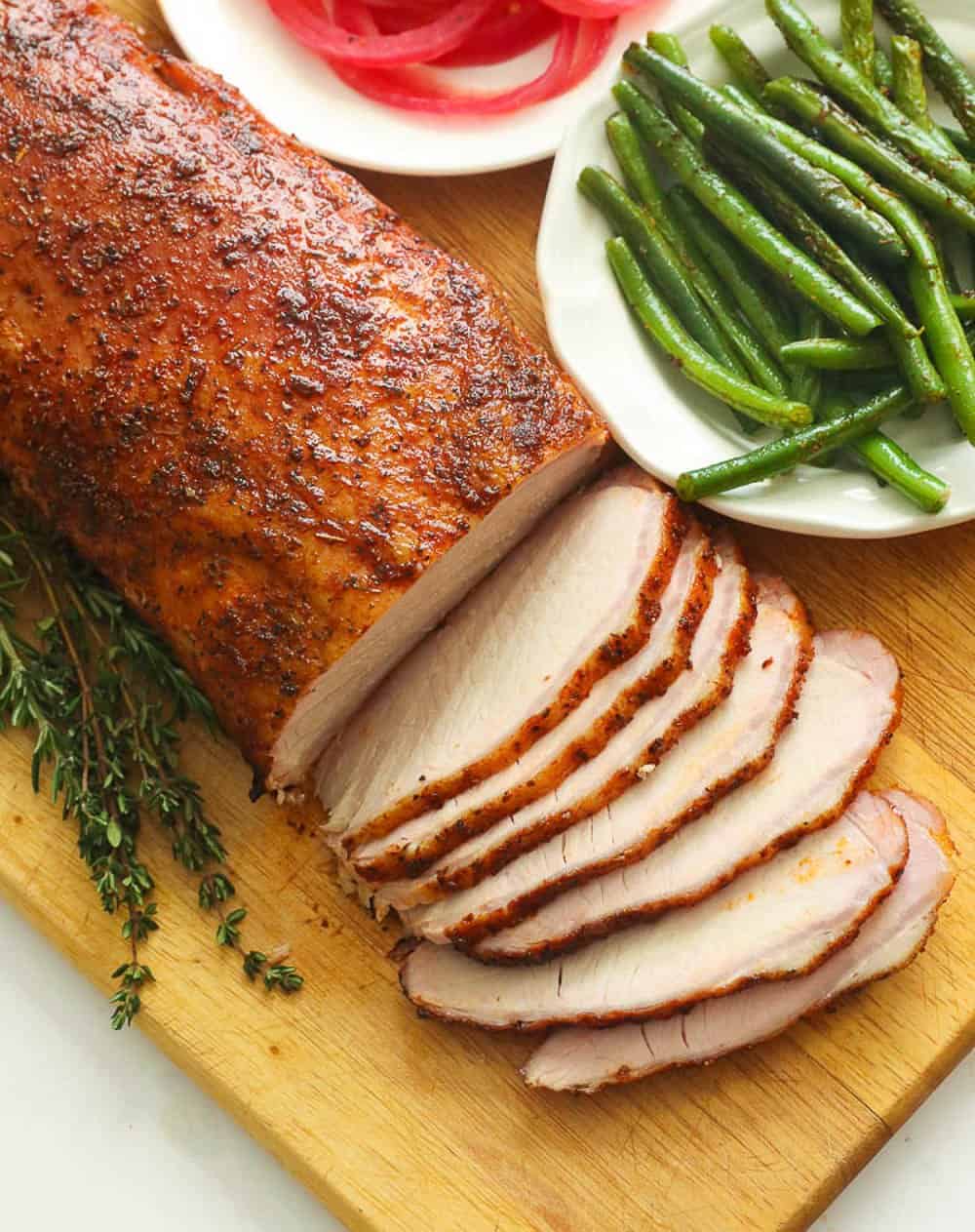
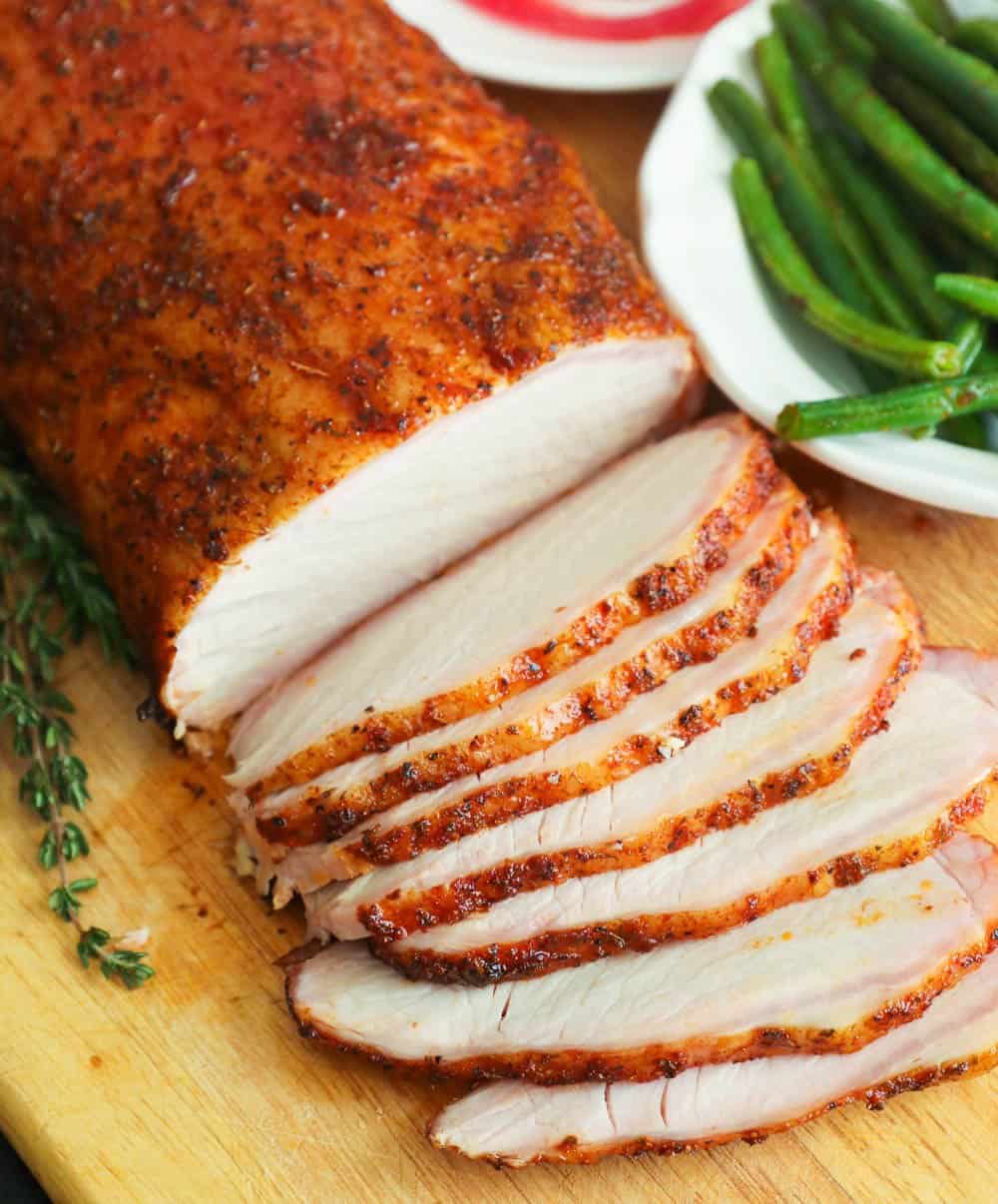
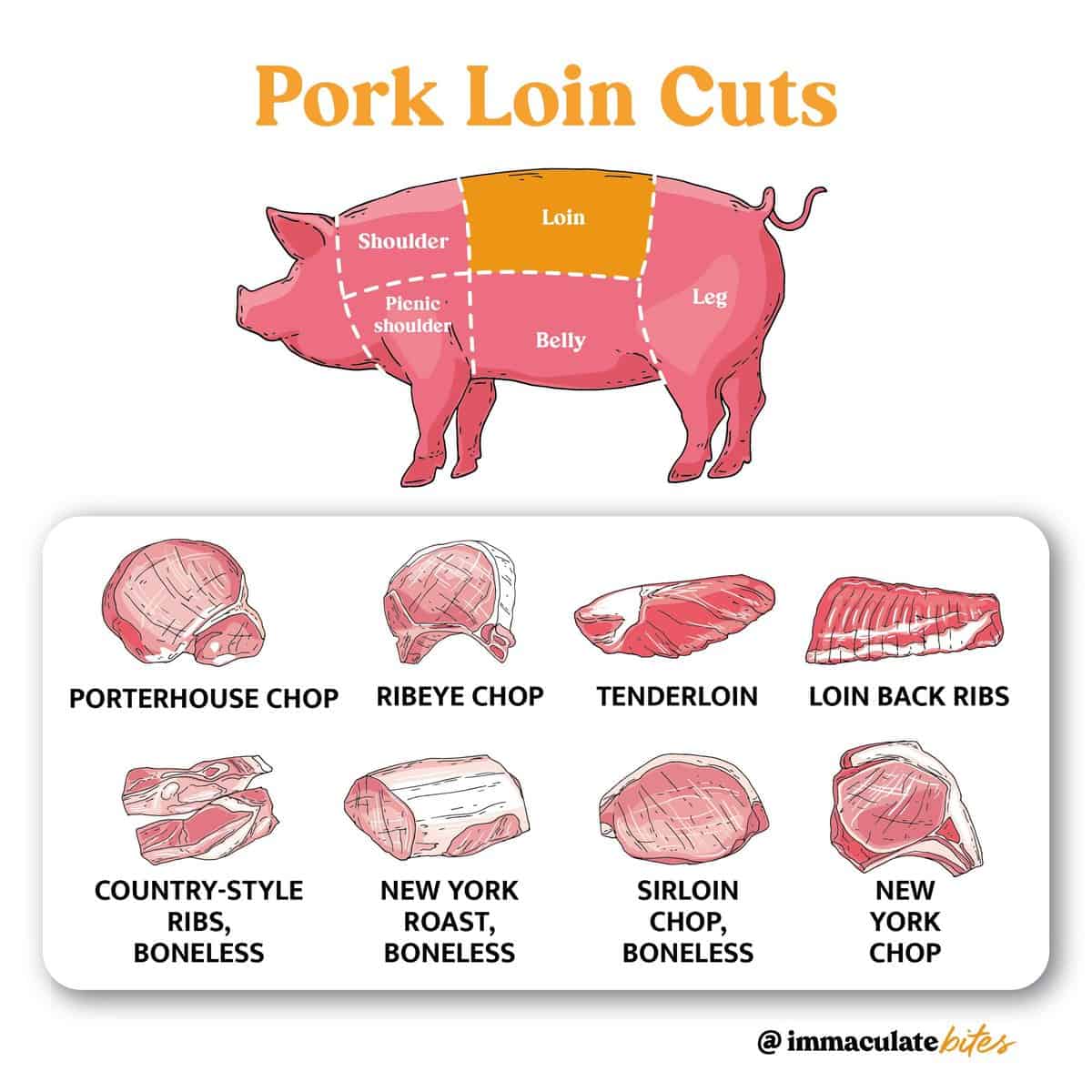
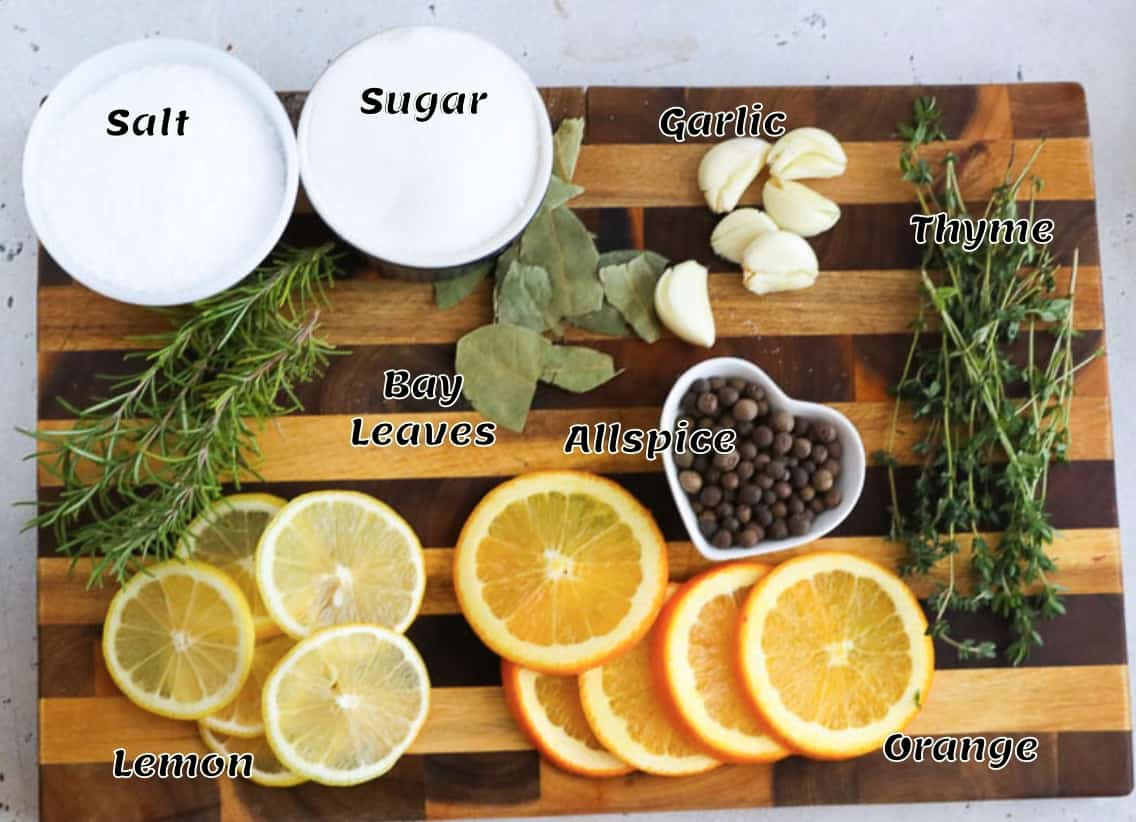
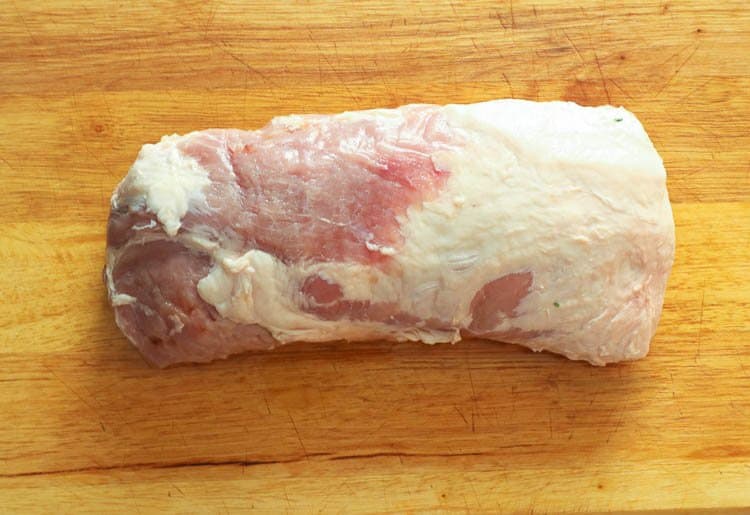
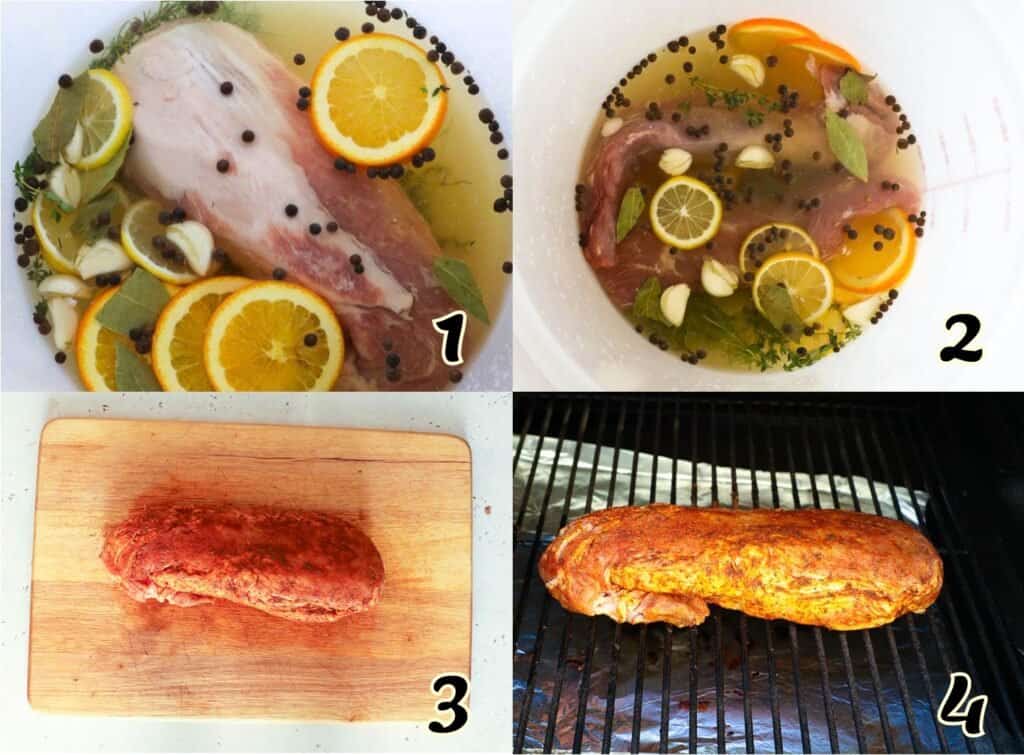
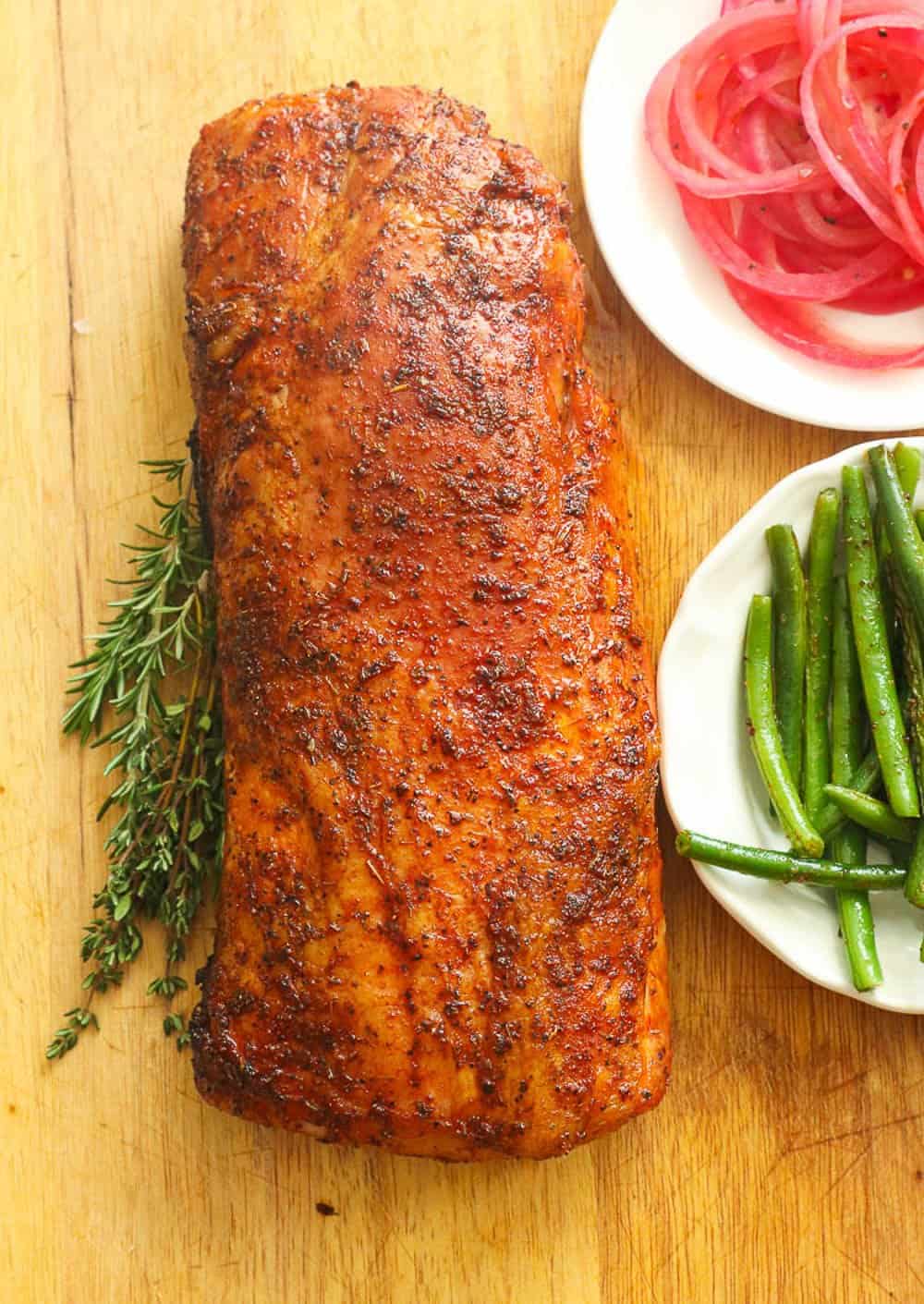
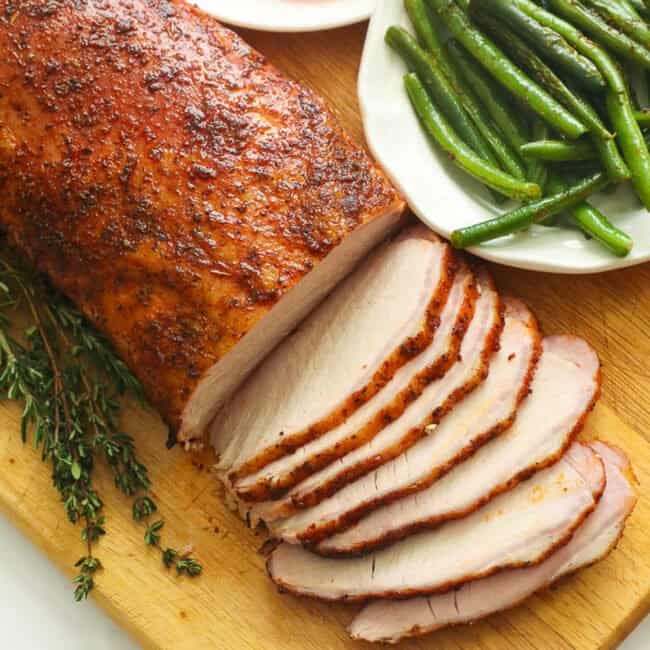

Leave a Review